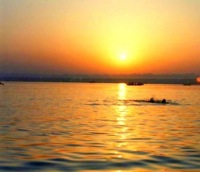I was introduced to her writings (via twitter) by my good friend and brilliant classical pianist, Wayne Mcevilly. He was highly recommending, her writing, and particularly her travelog with beautiful pictures, to anyone who would listen. A few days later, I finally read the article on her blog about her trip to India and her spiritual experiences there. Her writings were also filled with articles and references to her experiences as a scientist. Over time, I noticed that her comments were always measured, insightful, respectful and introspective – the sign of one who ‘thinks deeply before they speak’. One day, I decided to go behind the writing – to see what we could learn from her, that could help us all in our respective spiritual journeys.
So, it is with great excitement, I bring to you, a new edition of my interview series – Ten questions with Scientist, Author, Poet, Indophile and Yoga practitioner – Dr. J. J. Brown, Ph.D.
1. How did you get involved in science?
I’ve had a tendency to examine living and dead things since childhood, but in high school I really didn’t like science classes at all. I settled on science when I discovered Genetics. From my first undergraduate Genetics course to the last one for the PhD, I just loved every single one of them. Think of it, to understand where the physical components of living creatures come from and how this is controlled—it’s fascinating. From monk Gregor Mendel’s peas, one of the first things you learn in science class, to the variegated colors of transposons in corn, I was hooked by the stories of Genetics.
2. Were there any specific challenges being a woman scientist?
My mentor during my PhD studies was Nobel laureate Dr. Barbara McClintock, so I had one wonderful example of a woman scientist in front of me. This made all the difference. Of course, in the US, women in science–Science Technology Engineering and Math, STEM, are seen differently by men than men are generally. So a person must be particularly careful not to be used or abused. It is ever so common, but not inevitable.
3. You are also a prolific writer and author – what brought you to writing?
Living in a socially isolated and secluded rural area, as well as my parents having a tremendously varied library of books at home helped encourage my love of literature. I kept a library for my daughters too as a parent, and they both love to read books and enjoy creative writing, even though they grew up in the city.
I had lots to say as a child, all the time in fact, and was continually told to be quiet. “Little girls were to be seen and not heard,” you know. So writing became the way to express myself. I don’t think the family or my teachers much appreciated anything I wrote, but at least it kept the ideas flowing to learn how to write them down. Now I take every tragic moment in life and turn it, unfold it, and let it shape a story. This is how I not only deal with, but come to enjoy the strangeness of my life experiences. Sometimes they are entertaining, sometimes a bit horrifying. I’m preparing a collection of 15 short stories, fiction, and the book will be ready to publish later this year.
4. Can you share a little about people who have had an influence on your spiritual path? Do you have any favorite spiritual book(s)?
Life is a spiritual journey. My parents were not very religious but were open-minded and they freely let me read all the books in their varied library, which made all the difference in the world. Then the leader of the local church was a wonderful influence on me, Sion Lyman, who was always reading us the selections about peace from the Christian Bible, none of the morbid or threatening parts. During college years I studied Buddhist texts, especially The Dhammapada and Zen poetry, and often visited a Zen Center in New York.
Indian scholars in New York introduced me to the Jataka tales and the Upanishads, which I love. I studied with a great philosopher, Anant Shri Vibhusit Acharya Mahamandaleshwar Sri 108 Swami Shivendra Puri Ji Maharaj from Bombay, when he visited the Indian doctors I worked with each year in New York. As texts, I really do love Shantideva’s ‘The Way of the Bodhisatva’, and Patanjali’s ‘Yoga’ book —two of my favorites. I return to them again and again.
5. What led you to visit India?
My work as a scientist led me to India, where I was invited to present my genetics research on hepatitis B virus at a conference in Varanasi. Visiting this holy place was transformational for me. I visited Indian doctors in Delhi to give an invited presentation, and returned to New York by way of beautiful Mumbai. It was a working trip but I experienced three very different faces of India in these three cities. The following year I returned to India, not for work, but to visit friends, and my teacher in Haridwar on the Ganges for a week. It was yet another completely different experience of this great country. We traveled together to Rishikesh and then Nainital up in the mountains, for a treasured glimpse of mountain life.
6. What do you think is the connection between science and spirituality? Can science exist without spirituality?
What we call spirit, is that which allows me to create and understand what we call science. And so for me, naturally science and spirit coexist among the living. Science without spirit would be dead. The scientific view means looking for explanations for causation and prediction. What could be more essentially spiritual than this? We use different words, and we are different people sometimes, but possibly looking for the same thing – answers, predictability, direction, hope. It may be a simplistic attitude, but in my view, all that lives is imbued completely with spirit. My experience is that science and spirituality co-exist in me.
7. How did you get interested in India from a spiritual perspective?
I began studying yoga at 16 at home. I was not aware that it was actually from India, but I practised yoga every day from then on for about 20 years — both the breathing exercises and the postures. Yoga profoundly affected my physical and psychological development during adolescence. At around that time I also began drawing Hindu Gods – as a child I used to draw a lot in my free time. I did not know what they were (the Hindu Gods), but I somehow imagined them, and drew them and carved them.
None of us at home knew what they were, but soon I realized they resembled Brahma in the lotus, and Shiva dancing in the circle of fire. As an adult, I did keep many old scriptural books that I would read and re-read, like Yoga Patanjali, and the Bhagavad Gita. It was much later, when I was training Indian doctors in Molecular Biology techniques in the laboratory, that I fully ran into the spirituality of India and settled into studying it.
8. Can you share a little bit about your experiences in India? What impressed you? What saddened you?
The majestic Himalayas from the air, the holy temples of Varanasi from the ground, and inside the carved caves of Elephanta Island at Mumbai — these are some beautiful experiences of India. Sweet mint tea with Kashmiri rug merchants in their tiny shop, boat ride at dawn on the Ganges with a Varanasi sailor, a ride in Delhi atop an elephant with the animal caretaker – some unforgettable moments! Healthy diet was simple for me in India where vegetarian food is found everywhere, and alcohol was scarce. I was impressed by the compassion for animals in India and their respect for the forests, nature, temples, and spiritual traditions.
It only saddened me to see how so many wanted to leave India, when I clearly wanted to stay. I thought – if they only knew what New York is really like, then they may not want to go there that badly! But isn’t that always the case? We desire and hunger for what we do not know – this is our nature. They could not leave, I could not stay!
9. Can you share any specific lesson(s) that you learnt in your visits to India that could benefit those trying to progress/engage in their spiritual journey?
When it is possible, and it is not always possible, I learned that the two very important things to find in the journey are the “place” and the “teacher”. It is one thing to read a book about philosophy and quite another to visit blessed places, like the Ganges River. Touching the river, walking in the river, I would not trade that experience for any tourist attraction in India. So, if you can, spend time in blessed places like the temples and the Ganges and the mountains.
And the twin to the “place” is the “teacher”. Sometimes the journey seems motionless, but no matter where on the path you are, it will be more calm and directed in the presence of a blessed person who is an authentic teacher. So spend time with enlightened people in blessed places if possible – that is the best of what I learned and can share.
I would also like to thank your readers for this opportunity to talk with you about science, spirituality, books and most of all, India.
Author’s note: Connect with Dr. Brown and her work at her website or catch up with her on twitter.
Postscript: Some keen readers may be thinking – where is the tenth question? No, I did not make a mistake. The tenth question belongs to you! Please ask it in the form of a question, or in the form of a comment – either way, hit the comments section below. I am sure Dr. Brown will be delighted to hear from you!
Send this page to a friend


